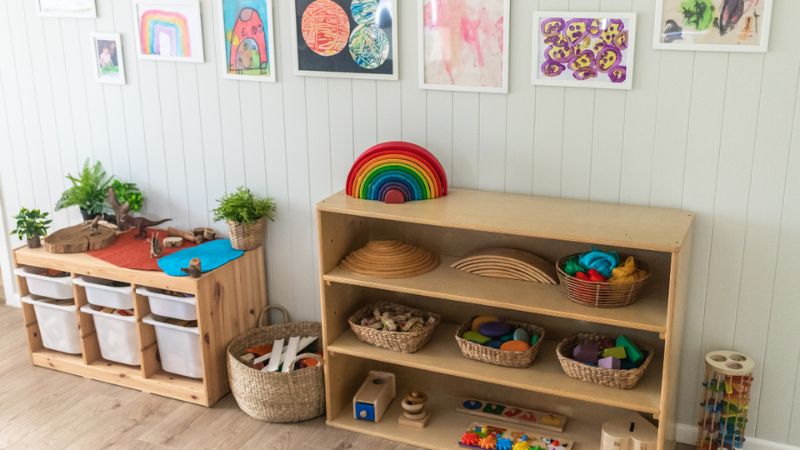If your toddler has a mountain of toys but still says “I’m bored,” you are not alone. Too many toys can overwhelm little kids, making it harder for them to focus and play deeply. This is where toy rotation makes all the difference.
Toy rotation is a simple system where only a few toys are available at a time, while the rest are stored and switched out regularly. This approach keeps playtime feeling fresh and exciting without the need to keep buying more things. With a bit of planning, toy rotation can spark your child’s imagination, reduce clutter, and encourage longer, more meaningful play.
Table of Contents
What Is Toy Rotation?
Toy rotation is a straightforward parenting strategy that makes a big difference. It means putting away most toys and leaving out only a small selection for your toddler to play with. Every week or so, you swap those toys with others from storage. The goal is not to buy more, but to use what you already have in a smarter way.
This works so well because toddlers can become overwhelmed when too many options are available. With fewer choices, children are more likely to focus, use their imagination, and play for longer. They also rediscover toys they have not seen for a while with renewed excitement.
Toy rotation also encourages independent play. Children explore one set of toys more deeply, which helps develop attention span and creativity. As a bonus, your home feels far less cluttered.
Whether you are starting from scratch or adding to your collection, choosing toys with lasting play value is essential. Stores such as Mr Toys Toyworld offer a wide range of high-quality, engaging toys that are ideal for rotation. With the right setup, toy rotation can make playtime smoother for parents and more meaningful for children.
Getting Started: How to Set Up a Toy Rotation System
Starting a toy rotation system is easier than it sounds, and your toddler will thank you for it. Begin by sorting through all the toys. Remove the ones that are broken, duplicated, or no longer interesting.
Group the rest by type or play value, such as building sets, pretend play items, or puzzles. From there, choose a manageable batch of about eight to twelve toys to keep out at a time. Research shows toddlers engage more deeply when offered fewer toys, for example, four instead of sixteen.
For the others, think about clever storage solutions. Opaque bins, under-bed boxes, melamine baskets, or closet shelves keep unused toys out of sight and out of mind. Labelling containers can also help you stay organised. Rotate toys on a weekly or fortnightly schedule so playtime continues to feel fresh, focused, and fun for everyone.
Toy Rotation Schedules That Work
When it comes to rotating toys, timing matters more than precision. For toddlers aged one to three, a weekly or fortnightly schedule often works best. Young children have short attention spans, so new toys feel exciting every few days. For older toddlers, rotating every two to four weeks can be just as effective. This keeps interest high without too much change.
Watching your little one at play gives you the best clues about when to swap toys. If they seem bored or consistently ignore a particular item, it may be time to rotate it out or bring back a favourite sooner. Do not forget to involve your toddler in the process.
Letting them help choose the next batch builds excitement and fosters independence. In short, begin with a schedule, observe how your child plays, and make toy switching a fun, shared activity.
Simple Toy Rotation Hacks
Keeping toddler play fresh does not have to be complicated. Small strategies can make a big difference. Try themed rotations, such as grouping toys by colours, animals, pretend play, or building blocks.
Theme-based bins add variety and make each switch feel special. Labelling bins or baskets makes swapping toys easier and helps keep the process organised.
Another useful trick is to mix new items with familiar favourites. This combination keeps toddlers excited while providing comfort through familiarity. Do not forget to rotate books as well. Watching your child rediscover storytime favourites highlights how powerful toy and book rotation can be in keeping playtime engaging.
Together, these simple hacks bring joy to your toddler and peace of mind to you. They create playtime that is creative, engaging, and refreshingly easy to manage.
Benefits of Toy Rotation
Let’s be honest: too many toys can make play feel like a chore rather than fun. This is where toy rotation shines. When toys are rotated, toddlers spend more time playing creatively with each item instead of quickly moving between dozens of options.
With fewer distractions, screen time naturally becomes less appealing. Seeing a favourite toy feel “new” again can spark curiosity and keep boredom away. Toy rotation also teaches children to value what they have.
Because the toys available hold more meaning, each one receives attention and care. Parents also benefit, since tidying up becomes much faster when fewer toys are out. Toy rotation keeps play exciting, sparks creativity, reduces clutter, and helps both toddlers and parents find joy in the little things again.
Less Toys, More Meaningful Play
Toy rotation is not about doing more. It is about doing less in a more thoughtful way. With just a few toys available at a time, children focus, explore, and play more deeply. This keeps play fresh, reduces clutter, and offers both toddlers and parents a calmer, more joyful experience. It is a simple change with a significant impact.



